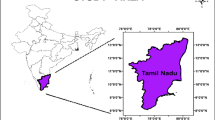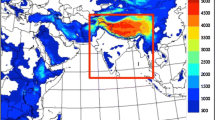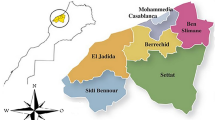Abstract
Climate change caused by anthropogenic activities has generated a variety of research focusing on investigating the past climate, predicting the future climate and quantifying the change in climate extreme events by using different climate models. Climate extreme events are valuable to evaluate the potential impact of climate change on human activities, agriculture and economy and are also useful to monitor the climate change on global scale. Here, a Regional Climate Model (RCM) simulation is used to study the future variations in the temperature extreme indices, particularly change in frequency of warm and cold spells duration over Pakistan. The analyses are done on the basis of simulating two 30 years simulations with the Hadley Center’s RCM PRECIS, at a horizontal resolution of 50 km. Simulation for the period 1961–1990 represents the recent climate and simulation for the period 2071–2100 represents the future climate. These simulations are driven by lateral boundary conditions from HadAM3P GCM of Hadley centre UK. For the validation of model, observed mean, maximum and minimum temperatures for the period 1961–1990 at all the available stations in Pakistan are first averaged and are then compared with the PRECIS averaged grid-box data. Also the observed monthly gridded data set of Climate Research Unit (UK) data is used to validate the model. Temperature indices in the base period as well as in future are then calculated and the corresponding change is observed. Percentile based spatial change of temperature shows that in summer, increase in daily minimum temperature is more as compared to the increase of daily maximum temperature whereas in winter, the change in maximum temperature is high. The occurrence of annual cold spells shows significantly decreasing trend while for warm spells there is slight increasing trend over Pakistan.
Similar content being viewed by others
References
Alexander LV et al (2006) Global observed changes in daily climate extremes of temperature and precipitation. J Geophys Rev 111(d5):D05109
Bohm U, Kucken M, Hauffe D, Gerstengarbe F, Werner P et al (2004) Reliability of regional climate model simulations of extremes and of long-term climate. Nat Hazards Earth Syst Sci 4:417–431
Cox P, Betts R, Bunton C, Essery R, Rowntree PR, Smith J (1999) The impact of new land surface physics on the GCM simulation of climate and climate sensitivity. Clim Dyn 15:183–203
Giorgi F, Hewitson B, Christensen J, Hulme M, von Storch H, Whetton P, Jones R, Mearns L, Fu C (2001) Regional climate information—evaluation and projections. In: Climate change 2001: the scientific basis. Contribution of working group I to the TAR of the intergovernmental panel on climate change (IPCC). Cambridge University Press, Cambridge, 881 pp
Gordon C, Cooper C, Senior CA, Banks H, Gregory JM, Johns TC, Mitchell JFB, Wood RA (2000) The simulation of SST, sea ice extents and ocean heat transports in a version of the Hadley Centre coupled model without flux adjustments. Clim Dyn 16:147–168
Huth R, Pokorna L (2005) Simultaneous analysis of climatic trends in multiple variables: an example of application of multivariate statistical methods. Intl J Climatol 25:469–484
Intergovernmental Panel on Climate Change (IPCC) (2007) In: Houghton JT, Callander BA, Varney SK (eds) Climate change. Cambridge Univ. Press, New York, pp 153, 303
Jones R, Noguer M, Hassell D, Hudson D, Wilson S, Jenkins G, Mitchell J (2004) Generating high resolution climate change scenarios using PRECIS. Met Office Hadley Centre, Exeter, 40 pp
New M, Hulme M, Jones PD (1999) Representing twentieth century space-time climate variability. Part 1: development of a 1961–90 mean monthly terrestrial climatology. J Climate 12:829-856
Pope VD, Gallani ML, Rowntree PR, Stratton RA (2000) The impact of new physical parametrizations in the Hadley Centre climate model–HadAM3. Clim Dyn 16:123–146
Tebaldi C, Hayhoe K, Arblaster J, Meehl G (2006) Going to the extremes: an inter-comparison of model-simulated historical and future changes in extreme events. Clim Change 79:185–211. doi:10.1007/s10584-006-9051-4
Zhang X, Yang F (2004) RClimDex (1.0) User Guide, Climate Research Environment Canada, Downsview, Ontario, Canada
Author information
Authors and Affiliations
Corresponding author
Rights and permissions
About this article
Cite this article
Islam, S.u., Rehman, N. & Sheikh, M.M. Future change in the frequency of warm and cold spells over Pakistan simulated by the PRECIS regional climate model. Climatic Change 94, 35–45 (2009). https://doi.org/10.1007/s10584-009-9557-7
Received:
Accepted:
Published:
Issue Date:
DOI: https://doi.org/10.1007/s10584-009-9557-7




